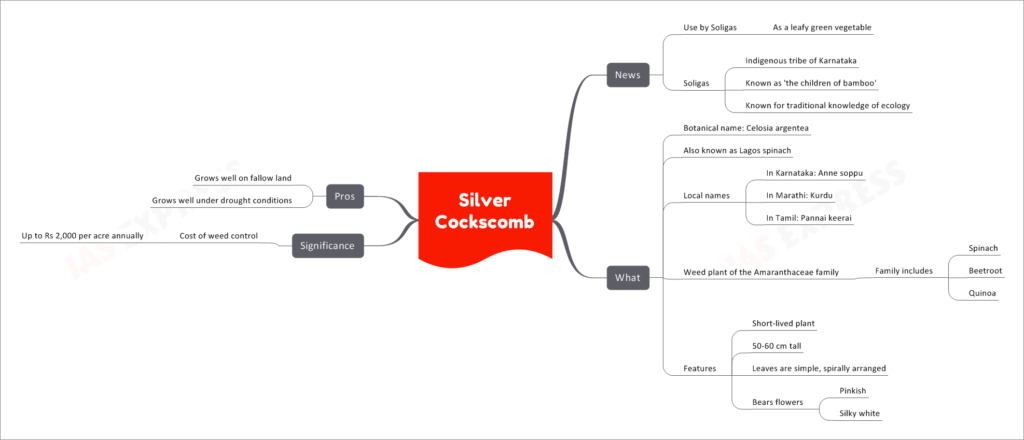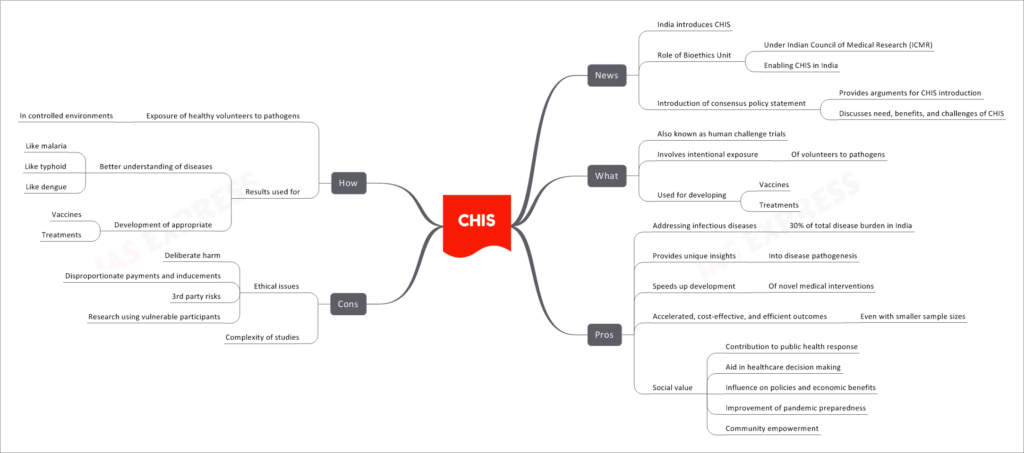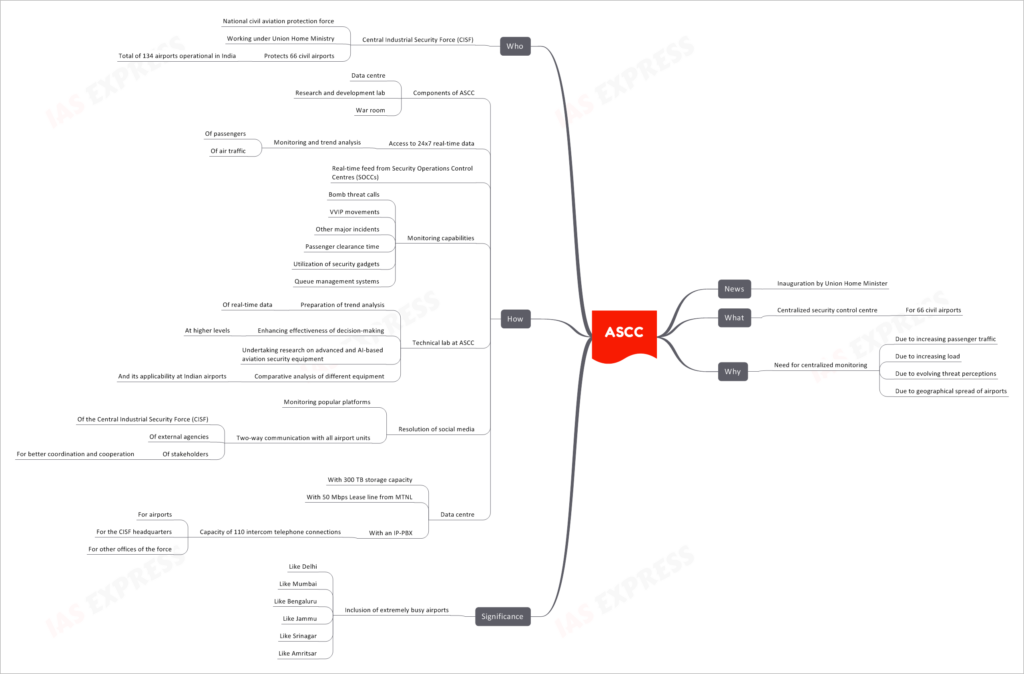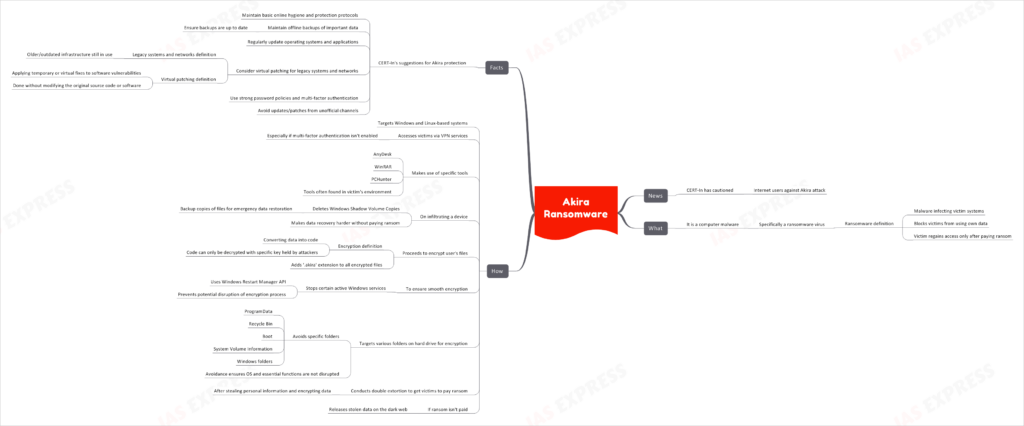[Newsbits] 24.07.2023

National Broadcasting Day 2023
National Broadcasting Day is observed on July 23rd to create awareness of the impact of radio broadcasting. It marks the start of organized radio broadcasts in India, which began in 1927 with the establishment of the India Broadcasting Company, the country's first radio company. Although it was later liquidated within three years, radio broadcasting in India continued to grow, leading to the establishment of the Indian Broadcasting Service in April 1930, which was later renamed as All India Radio (AIR) on June 8th. Over the years, AIR expanded and became an integral part of the Department of Information and Broadcasting in 1941, eventually becoming one of India's primary broadcasting networks.
Historical Timeline
- 1927: Establishment of India Broadcasting Company, the first radio company in India, leading to the commencement of organized radio broadcasts.
- April 1930: The establishment of Indian Broadcasting Service.
- June 8th: Indian Broadcasting Service renamed as All India Radio (AIR).
- 1941: AIR placed under the Department of Information and Broadcasting.
- By the time of Independence: AIR had six stations located in Delhi, Mumbai, Kolkata, Chennai, Lucknow, and Tiruchirapalli.
- July 23rd, 1977: Broadcasting began in Chennai.
- Since 1956: AIR officially known as Akashvani, a name derived from a 1938 poem by Rabindranath Tagore.
Facts
- The iconic Akashvani tune, which is synonymous with All India Radio, was composed by Walter Kauffman, an Indian Jewish refugee, in 1930. This tune has become a significant part of Indian radio culture and history.
National Broadcasting Day is an important occasion to recognize the transformative role of radio in India's media landscape and its contribution to the dissemination of information and entertainment across the nation. As radio continues to evolve alongside other forms of media, its legacy as a powerful medium of communication remains integral to India's cultural and communication heritage.
Silver Cockscomb
The Silver Cockscomb has garnered attention for its use as a leafy green vegetable by the Soligas, an indigenous tribe of Karnataka, who are known for their traditional knowledge of ecology.
What
- Botanical Name: Celosia argentea
- Also Known as: Lagos spinach
- Local Names:
- In Karnataka: Anne soppu
- In Marathi: Kurdu
- In Tamil: Pannai keerai
- The Amaranthaceae family includes other well-known plants like spinach, beetroot, and quinoa.
- Features:
- The Silver Cockscomb is a short-lived plant, typically reaching a height of 50-60 cm.
- Its leaves are simple and spirally arranged.
- The plant bears flowers that are pinkish and silky white in color.
Significance
- The Soligas, an indigenous tribe of Karnataka, have been using the Silver Cockscomb as a leafy green vegetable in their traditional diet.
- The cost of weed control associated with the Silver Cockscomb can be substantial, reaching up to Rs 2,000 per acre annually.
Pros
- The Silver Cockscomb demonstrates certain advantages:
- It grows well on fallow land, making it potentially useful for land restoration and cultivation in abandoned areas.
- It is resilient and can thrive under drought conditions, suggesting its potential as a crop that requires less water and can withstand arid environments.
Conclusion
The Silver Cockscomb, also known as Lagos spinach, is a weed plant from the Amaranthaceae family. Despite its status as a weed, the indigenous Soligas tribe in Karnataka has found a practical use for it as a leafy green vegetable in their traditional cuisine. Moreover, its ability to grow on fallow land and withstand drought conditions could present opportunities for land reclamation and agricultural resilience in challenging environments. However, the cost of controlling its growth as a weed must also be considered in regions where it may become invasive.
Controlled Human Infection Studies
Controlled Human Infection Studies (CHIS), also known as human challenge trials, have been introduced in India. The Bioethics Unit under the Indian Council of Medical Research (ICMR) plays a crucial role in enabling CHIS in the country. A consensus policy statement has been introduced to provide arguments for CHIS's introduction, discussing the need, benefits, and challenges associated with such studies.
What
- Controlled Human Infection Studies involve intentional exposure of volunteers to pathogens. These studies are primarily used for the development of vaccines and treatments.
Pros
- Addressing Infectious Diseases: CHIS can help in tackling infectious diseases that contribute to 30% of the total disease burden in India.
- Unique Insights: These studies provide researchers with unique insights into disease pathogenesis.
- Speeding up Development: CHIS accelerates the development of novel medical interventions.
- Cost-Effective and Efficient Outcomes: CHIS can lead to accelerated, cost-effective, and efficient outcomes, even with smaller sample sizes.
- Social Value: The studies offer various social benefits, including contributing to public health responses, aiding healthcare decision-making, influencing policies and economic benefits, improving pandemic preparedness, and empowering communities.
Cons
- Ethical Issues: CHIS raises ethical concerns due to deliberate harm caused to volunteers, the possibility of disproportionate payments and inducements, risks to third parties, and the involvement of vulnerable participants in research.
- Complexity of Studies: Conducting CHIS can be complex and requires careful planning and ethical considerations.
How
- CHIS involves exposing healthy volunteers to pathogens in controlled environments.
- The results obtained from these studies are used to better understand diseases like malaria, typhoid, and dengue, and to develop appropriate vaccines and treatments.
Conclusion
Controlled Human Infection Studies (CHIS) present a potential pathway for addressing infectious diseases and accelerating the development of medical interventions in India. While these studies offer valuable insights and social benefits, they also come with ethical challenges that must be carefully addressed. With the involvement of the Bioethics Unit under the Indian Council of Medical Research, the introduction of CHIS in India is expected to be guided by a thoughtful and responsible approach.
Aviation Security Control Centre
Recently, the center was inaugurated by the Union Home Minister to address the growing challenges posed by increasing passenger traffic, evolving threat perceptions, and the geographical spread of airports.
What
- The ASCC serves as a centralized security control center for 66 civil airports in India.
Why
- The need for centralized monitoring arises due to:
- Increasing passenger traffic and load at airports.
- Evolving threat perceptions in the aviation sector.
- The geographical spread of airports across the country.
Significance
- The ASCC includes extremely busy airports like:
- Delhi
- Mumbai
- Bengaluru
- Jammu
- Srinagar
- Amritsar
How
Components of ASCC
- The ASCC consists of the following components:
- Data centre
- Research and development lab
- War room
Access to 24x7 real-time data
- The center has access to real-time data, allowing monitoring and trend analysis of:
- Passengers
- Air traffic
Real-time feed from Security Operations Control Centres (SOCCs)
- The ASCC receives real-time feeds from SOCCs for improved coordination and monitoring.
Monitoring capabilities
- The ASCC is equipped to monitor various aspects, including:
- Bomb threat calls
- VVIP movements
- Other major incidents
- Passenger clearance time
- Utilization of security gadgets
- Queue management systems
Technical lab at ASCC
- The center's technical lab is responsible for:
- Preparing trend analysis of real-time data.
- Enhancing decision-making at higher levels.
- Conducting research on advanced and AI-based aviation security equipment.
- Comparative analysis of different equipment and its applicability at Indian airports.
Resolution of social media
- The ASCC actively monitors popular social media platforms and facilitates two-way communication with all airport units, CISF headquarters, external agencies, and stakeholders for better coordination and cooperation.
Data centre
- The data centre has a storage capacity of 300 TB.
- It is connected with a 50 Mbps Lease line from MTNL.
- The data center includes an IP-PBX with a capacity of 110 intercom telephone connections for airports, CISF headquarters, and other offices of the force.
Who
- The ASCC is managed by the Central Industrial Security Force (CISF), which is the national civil aviation protection force working under the Union Home Ministry.
- The CISF is responsible for the protection of 66 civil airports out of a total of 134 operational airports in India.
Conclusion
The Aviation Security Control Centre (ASCC) plays a vital role in enhancing aviation security across India's civil airports. Through its centralized monitoring, real-time data analysis, and efficient communication channels, the ASCC ensures a comprehensive approach to tackle the increasing challenges and threats in the aviation sector. With its focus on advanced research and technology, the ASCC aims to provide a safe and secure environment for air travelers and airport operations.
Mediums of Instruction in CBSE Schools
News
- CBSE schools have begun using 22 languages as mediums of instruction.
Highlights
- The mediums of instruction in CBSE schools have been expanded.
- The expansion includes a total of 22 languages.
- These languages include various regional languages.
- Mother tongues have been incorporated.
- English and Hindi continue to be part of the mediums of instruction.
- The expansion includes a total of 22 languages.
Reasons for the Change
- The aim is to promote linguistic diversity.
- The change is designed to provide a more comprehensive and linguistic learning experience.
Significance
- The move aligns with the National Education Policy 2020.
Pros
- The use of familiar languages, such as students' regional languages or mother tongues, has been shown to enhance comprehension.
Implementation
- The National Council of Educational Research and Training (NCERT) is supporting the initiative.
- NCERT is developing textbooks in the 22 identified languages.
- Examinations will also be conducted in these languages.
In conclusion, the implementation of this change is anticipated to boost student comprehension by making education more accessible and relatable to them. This significant shift aligns with the National Education Policy 2020, and with the support from NCERT, we can look forward to seeing the positive impacts on student learning in the near future.
Akira Ransomware
In recent news, CERT-In has issued a warning to internet users against Akira attacks.
What is Akira Ransomware?
- Akira is a computer malware, specifically a ransomware virus.
- Ransomware is a type of malware that infects victim systems and blocks the victims from using their own data.
- The victim can regain access only upon paying the ransom.
How does Akira Operate?
- Akira targets Windows and Linux-based systems.
- It accesses victims via VPN services, especially when multi-factor authentication isn't enabled.
- It uses tools like AnyDesk, WinRAR, and PCHunter, which are often found in the victim's environment.
Infiltration and Encryption
- Upon infiltrating a device, Akira deletes the Windows Shadow Volume Copies, which are backup copies of files used for emergency data restoration.
- After deleting the Shadow Volume Copies, it becomes harder for the user to recover their files without paying the ransom.
- It then proceeds to encrypt the user's files by converting data into a code that can only be decrypted with a specific key, which is held by the attackers.
- During the encryption process, Akira adds a '.akira' extension to the names of all encrypted files.
- To ensure a smooth encryption without interruptions, the ransomware stops certain active Windows services using the Windows Restart Manager API.
Targets and Extortion
- Akira targets various folders on the hard drive to encrypt files but avoids specific folders such as ProgramData, Recycle Bin, Boot, System Volume Information, and Windows folders.
- After stealing personal information and encrypting the data, it conducts double extortion to get the victims to pay the ransom.
- If the victim refuses to pay the ransom, the stolen data is released on the dark web.
Protective Measures Against Akira
- Maintain basic online hygiene and protection protocols.
- Maintain offline backups of important data and ensure that these backups are up to date.
- Regularly update operating systems and applications.
- Consider 'virtual patching' to safeguard legacy systems and networks.
- Use strong password policies and multi-factor authentication.
- Avoid using updates/patches available in any unofficial channel.
With Akira ransomware posing a considerable threat to both Windows and Linux-based systems, adopting preventative measures recommended by CERT-In can significantly mitigate the risk of attacks. As always, maintaining online hygiene and staying updated on system patches is essential in combating such cybersecurity threats.
Bedaquiline – Side Effects & Patent Rejection
Recently, the Indian Patent Office rejected Johnson & Johnson's application to extend its patent on the tuberculosis treatment, bedaquiline, opening the door for domestic generic players.
As India accounts for nearly 29% of the 10.6 million tuberculosis cases worldwide, this decision is significant in the country's efforts to eradicate tuberculosis by 2025.
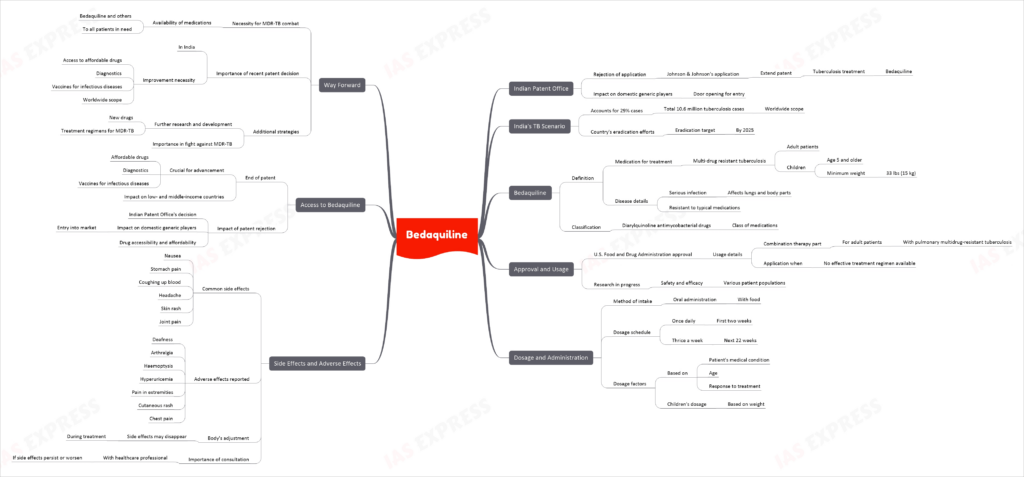
What is Bedaquiline?
Bedaquiline is a medication used along with at least three other medications to treat multi-drug resistant tuberculosis (MDR-TB) in adults and children aged 5 years and older who weigh at least 33 lbs (15 kg). MDR-TB is a serious infection that affects the lungs and other parts of the body and cannot be treated with other medications typically used for the condition. Bedaquiline belongs to a class of medications called diarylquinoline antimycobacterial drugs.
Approval and Usage
Bedaquiline is approved by the U.S. Food and Drug Administration (FDA) for use as part of a combination therapy in adults with pulmonary multidrug-resistant tuberculosis (MDR-TB) when an effective treatment regimen cannot otherwise be provided. The safety and efficacy of bedaquiline in different patient populations are still being studied.
Dosage and Administration
Bedaquiline is taken orally with food, usually once daily for the first two weeks, followed by three times a week for the next 22 weeks. The dosage is based on the patient's medical condition, age, and response to treatment. Children's dosage is also based on weight.
Side Effects and Adverse Effects
Some common side effects of bedaquiline include nausea, stomach pain, coughing up blood, headache, skin rash, and joint pain. Other adverse effects reported include deafness, arthralgia, haemoptysis, hyperuricemia, pain in the extremities, cutaneous rash, and chest pain. These side effects may go away during treatment as the body adjusts to the medication. It is important to consult a healthcare professional if side effects persist or worsen.
Access to Bedaquiline
The end of the bedaquiline patent is a crucial development for moving forward with affordable drugs, diagnostics, and vaccines for infectious diseases in low- and middle-income countries. With the Indian Patent Office's rejection of Johnson & Johnson's application to extend its patent on bedaquiline, domestic generic players can now enter the market, making the drug more accessible and affordable.
Way Forward
To effectively combat MDR-TB, it is essential to ensure that bedaquiline and other life-saving medications are made available to all patients who need them. The recent patent decision in India is a step in the right direction, but continued efforts are needed to improve access to affordable drugs, diagnostics, and vaccines for infectious diseases worldwide. Additionally, further research and development of new drugs and treatment regimens for MDR-TB are crucial in the ongoing fight against this devastating disease.
Tele Manas – Features, Services, Achievements
Recently, a counselor at the Tele Manas helpline in Srinagar prevented a caller from self-harm, highlighting the importance of mental health assistance in India.
Tele Manas, or Tele Mental Health Assistance and Networking Across States (Tele-MANAS), is an initiative launched by the Union Ministry of Health and Family Welfare to provide free tele-mental health services across the country, particularly catering to people in remote or under-served areas.
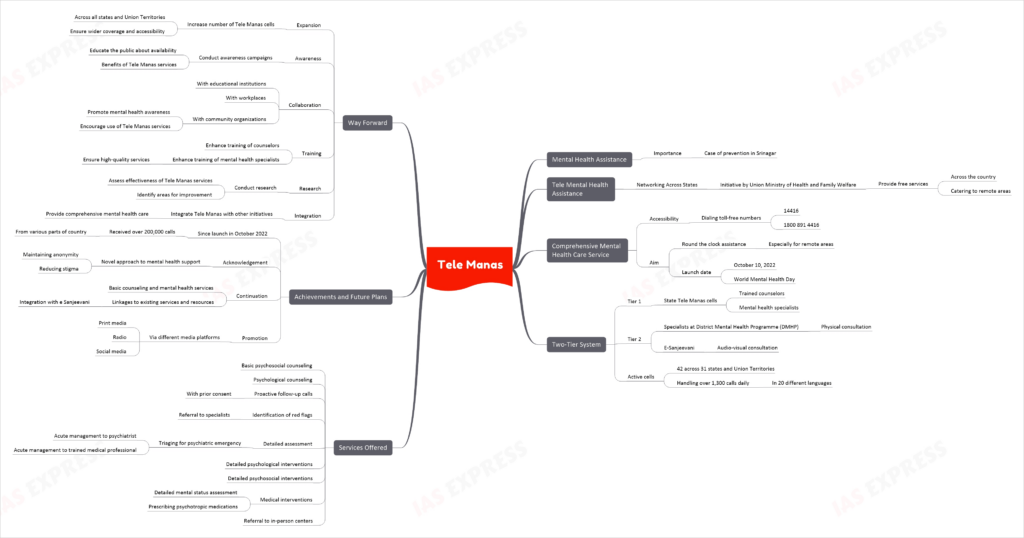
Tele Manas: A Comprehensive Mental Health Care Service
Tele Manas is a comprehensive mental health care service that can be accessed by dialing toll-free numbers 14416 or 1800 891 4416.
The initiative aims to provide mental health assistance round the clock, especially for people in remote or under-served areas. It was launched on October 10, 2022, on the occasion of World Mental Health Day.
Two-Tier System
- Tier 1 comprises state Tele Manas cells, which include trained counselors and mental health specialists.
- Tier 2 comprises specialists at District Mental Health Programme (DMHP) or Medical College resources for physical consultation and/or e-Sanjeevani for audio-visual consultation.
Currently, there are 42 active Tele Manas cells across 31 states and Union Territories, handling over 1,300 calls daily in 20 different languages.
Services Offered
Tele Manas offers various services, including:
- Basic psychosocial and psychological counseling.
- Proactive follow-up calls with prior consent.
- Identification of red flags and referral to specialists.
- Detailed assessment, triaging for any psychiatric emergency, or acute management to the psychiatrist or trained medical professional.
- Detailed psychological and psychosocial interventions.
- Medical interventions, including detailed mental status assessment and prescribing psychotropic medications.
- Referral to in-person centers.
Achievements and Future Plans
Since its launch in October 2022, Tele Manas has received over 200,000 calls from various parts of the country. The initiative has been acknowledged as a novel approach to enable people to seek support for their mental health issues while maintaining anonymity, thereby reducing the stigma generally surrounding mental health issues.
Tele Manas will continue to provide callers with basic counseling and mental health services, with linkages to existing vital services and resources, including integration with e Sanjeevani in the coming days. Promotion of Tele Manas services via different media platforms, such as print media, radio, and social media, is being carried out.
Way Forward
- Expansion: Increase the number of Tele Manas cells across all states and Union Territories to ensure wider coverage and accessibility.
- Awareness: Conduct awareness campaigns to educate the public about the availability and benefits of Tele Manas services.
- Collaboration: Collaborate with educational institutions, workplaces, and community organizations to promote mental health awareness and encourage the use of Tele Manas services.
- Training: Enhance the training of counselors and mental health specialists to ensure high-quality services.
- Research: Conduct research to assess the effectiveness of Tele Manas services and identify areas for improvement.
- Integration: Integrate Tele Manas with other mental health initiatives and programs to provide comprehensive mental health care.
In conclusion, Tele Manas is a significant step towards addressing mental health issues in India. By providing accessible and affordable mental health care services, it aims to improve the overall mental well-being of the population, particularly those in remote or under-served areas. With continued efforts to expand and improve the initiative, Tele Manas has the potential to make a lasting impact on the mental health landscape in India.
Yellow Sea – Geography, Climate, Issues
Recently, North Korea fired several cruise missiles into the Yellow Sea, situated between China and the Korean Peninsula. This event has brought attention to the Yellow Sea, a significant body of water in the region.
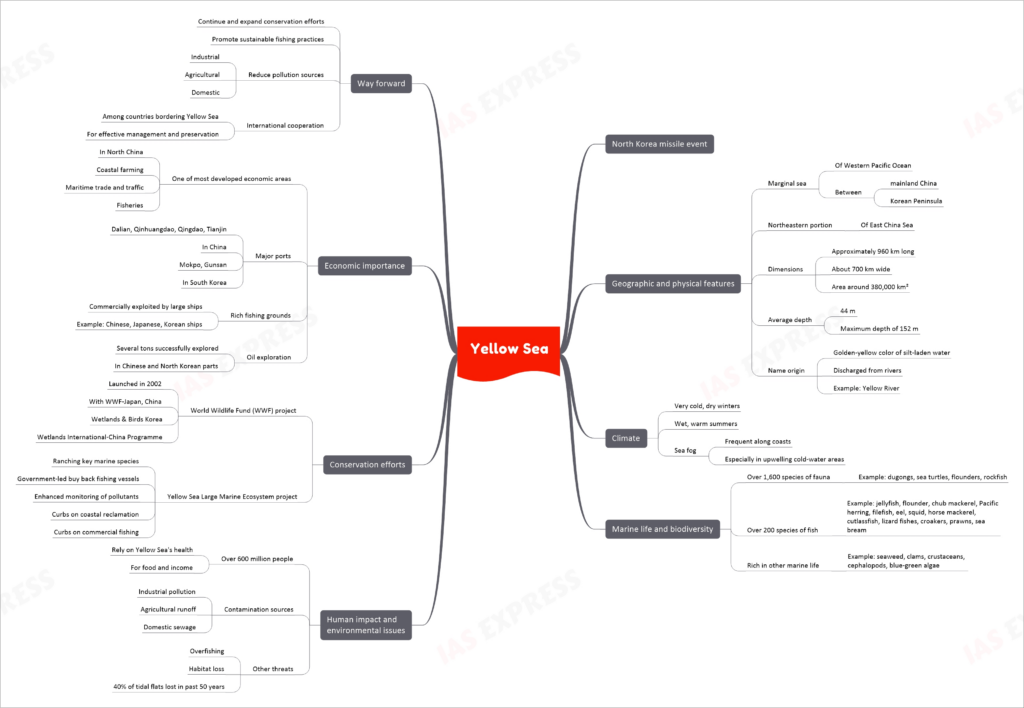
Geography and Physical Features
- The Yellow Sea is a marginal sea of the Western Pacific Ocean, located between mainland China and the Korean Peninsula.
- It is part of the northeastern portion of the East China Sea.
- The sea is approximately 960 km (600 mi) long from north to south and about 700 km (430 mi) from east to west, with an area of around 380,000 km² (150,000 sq mi).
- The average depth of the Yellow Sea is 44 m (144 ft), with a maximum depth of 152 m (499 ft).
- The sea gets its name from the golden-yellow color of the silt-laden water discharged from major rivers, such as the Yellow River.

Climate
- The Yellow Sea has a climate characterized by very cold, dry winters and wet, warm summers.
- Sea fog is frequent along the coasts, especially in upwelling cold-water areas.
Marine Life and Biodiversity
- The Yellow Sea is home to over 1,600 different species of fauna, including dugongs, sea turtles, flounders, and rockfish.
- Over 200 species of fish inhabit the Yellow Sea, such as jellyfish, flounder, chub mackerel, Pacific herring, filefish, eel, squid, horse mackerel, cutlassfish, lizard fishes, croakers, prawns, and sea bream.
- The sea is also rich in seaweed, clams, crustaceans, cephalopods, and blue-green algae.
Human Impact and Environmental Issues
- More than 600 million people, or 10% of the global population, live on or near the shores of the Yellow Sea and rely on its health for food and income.
- Industrial pollution, agricultural runoff, and domestic sewage have contaminated the Yellow Sea's coastal waters and habitats.
- Overfishing and habitat loss are other serious threats facing the region, with about 40% of the sea's tidal flats having been lost in the past 50 years.
Conservation Efforts
- In 2002, the World Wildlife Fund (WWF) launched a joint project with WWF-Japan and China, Wetlands & Birds Korea, and the Wetlands International-China Programme to conserve biodiversity in the Yellow Sea.
- The Yellow Sea Large Marine Ecosystem project has introduced innovative solutions such as ranching key marine species for reintroduction, government-led schemes to buy back fishing vessels, enhanced monitoring of pollutants, and curbs on coastal reclamation and commercial fishing.
Economic Importance
- The Yellow Sea is one of the most developed economic areas in North China, with coastal farming, maritime trade and traffic, and fisheries.
- Several major ports are located along the Yellow Sea, including Dalian, Qinhuangdao, Qingdao, and Tianjin ports in China, and Mokpo and Gunsan in South Korea.
- The rich fishing grounds of the Yellow Sea have been commercially exploited by large Chinese, Japanese, and Korean ships for many years.
- Several tons of oil have been successfully explored in the Chinese and North Korean parts of the sea.
Way Forward
To ensure the long-term health and sustainability of the Yellow Sea, it is crucial to continue and expand conservation efforts, promote sustainable fishing practices, and reduce pollution from industrial, agricultural, and domestic sources. International cooperation among the countries bordering the Yellow Sea is essential for the effective management and preservation of this vital marine ecosystem.
INS Kirpan – Background, Specifications, Vietnam
India recently gifted the indigenously-built missile corvette INS Kirpan to Vietnam, marking a significant milestone in the growing defense ties and strategic partnership between the two countries. This is the first time India has gifted a fully operational warship to a friendly foreign country.
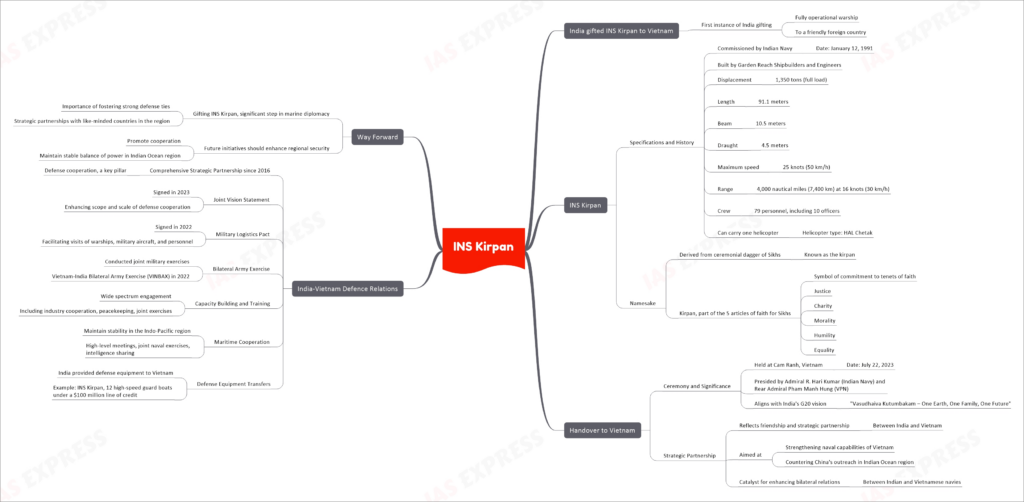
Background
INS Kirpan: Specifications and History
- INS Kirpan (P44) is a Khukri-class corvette commissioned by the Indian Navy on January 12, 1991.
- Built by Garden Reach Shipbuilders and Engineers.
- Displacement: 1,350 tons (full load).
- Length: 91.1 meters.
- Beam: 10.5 meters.
- Draught: 4.5 meters.
- Maximum speed: 25 knots (50 km/h).
- Range: 4,000 nautical miles (7,400 km) at 16 knots (30 km/h).
- Crew: 79 personnel, including 10 officers.
- Capable of carrying one helicopter (HAL Chetak).
INS Kirpan: Namesake
The name "INS Kirpan" is derived from the ceremonial dagger worn by Sikhs, known as the kirpan. The kirpan is one of the five articles of faith, often called the 5Ks, worn by initiated Sikhs as a reminder of their commitment to the tenets of their faith, including justice, charity, morality, humility, and equality.
Handover to Vietnam
Ceremony and Significance
The decommissioning and handing over ceremony of INS Kirpan to the Vietnam People's Navy (VPN) took place at Cam Ranh, Vietnam, on July 22, 2023. The ceremony was presided over by Admiral R. Hari Kumar, Chief of Naval Staff, Indian Navy, and Rear Admiral Pham Manh Hung, Deputy Commander-in-Chief and Chief of Staff, VPN. The transfer of INS Kirpan to the VPN resonates with India's G20 vision of "Vasudhaiva Kutumbakam – One Earth, One Family, One Future".
Strategic Partnership
The transfer of INS Kirpan to Vietnam is a reflection of the deep-rooted friendship and strategic partnership between India and Vietnam. This move is aimed at strengthening the naval capabilities of Vietnam and countering China's outreach in the Indian Ocean region. The transfer serves as a catalyst for enhancing bilateral relations between the two navies.
India-Vietnam Defence Relations
- Comprehensive Strategic Partnership: India and Vietnam share a Comprehensive Strategic Partnership since 2016, with defense cooperation being a key pillar of this partnership.
- Joint Vision Statement: In 2023, India and Vietnam signed a Joint Vision Statement on the India-Vietnam Defence Partnership towards 2030, aimed at enhancing the scope and scale of existing defense cooperation.
- Military Logistics Pact: The two countries signed a landmark military logistics pact in 2022, enabling their militaries to use each other's bases for repair and replenishment of supplies, and facilitating visits of warships, military aircraft, and personnel to each other's shores.
- Bilateral Army Exercise: The two countries have conducted joint military exercises, such as the Vietnam-India Bilateral Army Exercise (VINBAX) in 2022, aimed at strengthening mutual confidence and inter-operability between the Indian Army and Vietnam People's Army.
- Capacity Building and Training: India-Vietnam defense engagement spans a wide spectrum, including capacity building, industry cooperation, peacekeeping, and joint exercises.
- Maritime Cooperation: The two countries have been working together to maintain stability in the Indo-Pacific region and have strengthened defense ties through high-level meetings, joint naval exercises, and sharing of intelligence.
- Defense Equipment Transfers: India has provided defense equipment to Vietnam, such as the transfer of the INS Kirpan missile corvette and 12 high-speed guard boats under a $100 million line of credit.
Way Forward
The gifting of INS Kirpan to Vietnam is a significant step in India's marine diplomacy. It highlights the importance of fostering strong defense ties and strategic partnerships with like-minded countries in the region. Moving forward, India should continue to engage in such initiatives to enhance regional security, promote cooperation, and maintain a stable balance of power in the Indian Ocean region.
Fragile X Syndrome – Causes, Symptoms, Treatment
On the occasion of World Fragile X Day, India Gate was lit up in teal to raise awareness about Fragile X syndrome, a rare genetic disorder that causes intellectual disability and autism. Fragile X syndrome, also known as Martin-Bell syndrome, is the most commonly inherited form of developmental and intellectual disability, resulting from mutations in a gene on the X chromosome.

Causes of Fragile X Syndrome
Fragile X syndrome is caused by a mutation in the Fragile X Messenger Ribonucleoprotein 1 (FMR1) gene, which is found on the X chromosome. The FMR1 gene normally produces a protein called FMRP, which is essential for brain development. However, individuals with Fragile X syndrome do not produce this protein, leading to the symptoms associated with the condition.
Symptoms of Fragile X Syndrome
Symptoms of Fragile X syndrome can vary among individuals and are often milder in females than in males. Common symptoms include:
- Intellectual and learning problems, ranging from mild learning disorders to severe intellectual or developmental disabilities.
- Physical features, such as a narrow face, large head, large ears, flexible joints, flat feet, and a prominent forehead, which may develop during puberty.
- Social and behavioral problems, including attention disorders, hyperactivity, anxiety, and language-processing problems.
- Developmental delays, such as delayed speech and language development.
Treatment and Management
There is no single treatment for Fragile X syndrome, but there are treatments that help minimize the symptoms of the condition. Early intervention is crucial, as it provides the best chance for individuals with Fragile X to develop a full range of skills. Treatment options include:
- Educational and behavioral therapies to improve communication, social, and cognitive skills.
- Speech and language therapy.
- Occupational therapy and physical therapy to help with motor skills and coordination.
- Medications to manage behavioral problems, such as anxiety, aggression, and ADHD.
Way Forward
Research on Fragile X syndrome is ongoing, with recent studies focusing on the role of astrocytes in the atypical firing patterns of neurons in people with the condition. This new understanding could potentially lead to targeted treatments in the future. Additionally, raising awareness about Fragile X syndrome is crucial for early diagnosis and intervention, as well as for providing support to affected families.
Ludwigia Peruviana – Distribution, Impacts, Control Measures
Recently, an aquatic weed called Ludwigia peruviana has been posing a threat to the habitats of elephants in Tamil Nadu, India. This invasive species, also known as Peruvian primrose-willow or Peruvian water primrose, is native to Peru but has been introduced to many other countries for its attractive yellow flowers. It is now a common weed in swampy areas worldwide, causing ecological damage and affecting native vegetation.
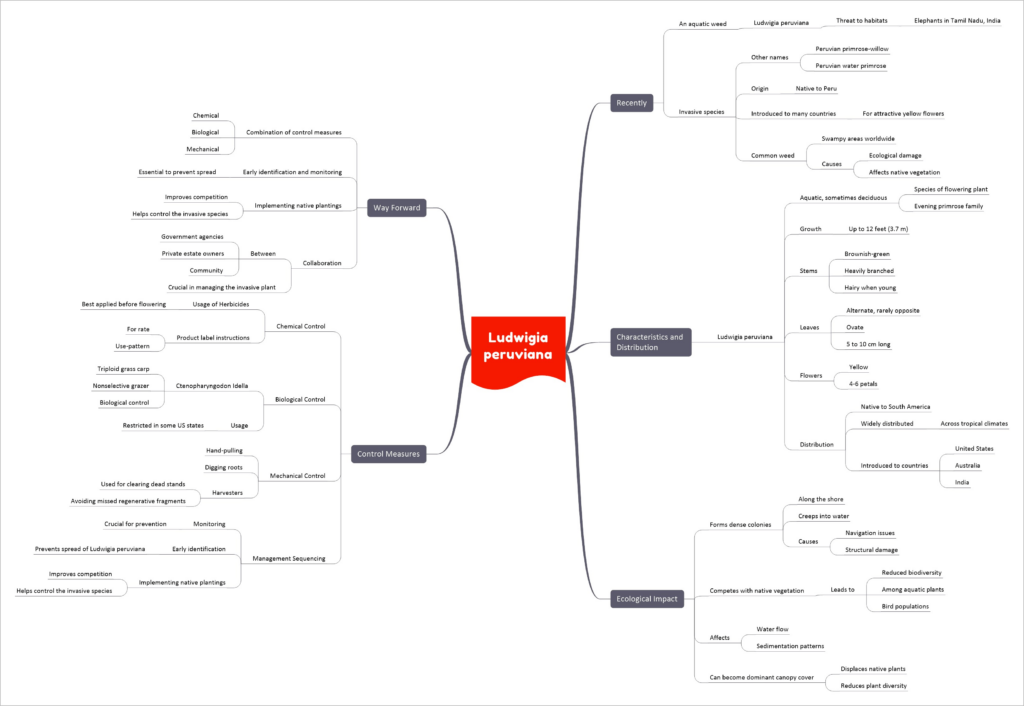
Characteristics and Distribution
- Ludwigia peruviana is an aquatic, sometimes deciduous species of flowering plant in the evening primrose family.
- It can grow up to 12 feet (3.7 m) in height.
- Stems are brownish-green, heavily branched, and hairy when young.
- Leaves are alternate, rarely opposite, ovate, and 5 to 10 cm long.
- The flowers are yellow with 4-6 petals.
- Native to South America and widely distributed across tropical climates.
- Introduced to countries like the United States, Australia, and India.
Ecological Impact
- Forms dense colonies along the shore and creeps into the water, causing navigation issues and structural damage.
- Competes with native vegetation, leading to reduced biodiversity among aquatic plants and bird populations.
- Reduces water flow and affects sedimentation patterns.
- Can become the dominant canopy cover, displacing native plants and reducing plant diversity.
Control Measures
- Chemical Control
- Herbicides can be used, best applied before flowering.
- Follow product label instructions for rate and use-pattern.
- Biological Control
- Ctenopharyngodon Idella (Triploid grass carp) can be used as a nonselective grazer for biological control.
- Use is restricted in some US states.
- Mechanical Control
- Hand-pulling and digging roots can be effective.
- Harvesters may be used for clearing dead stands, avoiding missed regenerative fragments.
- Management Sequencing
- Monitoring and early identification are crucial in preventing the spread of Ludwigia peruviana.
- Implementing native plantings can improve competition and help control the invasive species.
Way Forward
- Employ a combination of chemical, biological, and mechanical control measures for effective management.
- Early identification and monitoring are essential to prevent its spread.
- Implementing native plantings can improve competition and help control the invasive species.
- Collaboration between government agencies, private estate owners, and the community is crucial in managing this invasive plant.
If you like this post, please share your feedback in the comments section below so that we will upload more posts like this.

